IoT Healthcare Market: Leading Trends and Driving Factors
Updated: June 5, 2025
The impact of the Internet of Things (IoT) in healthcare is very real today. Think remote patient monitoring, more streamlined hospital processes, and optimized medication management – interest in these advancements in the IoT healthcare market isn’t going to wane anytime soon. With global challenges like aging populations and escalating rates of chronic diseases, the healthcare solutions provided by IoT couldn’t be more timely.
IoT’s fusion into healthcare is a robust shift towards more proactive and data-driven patient care. From wearable IoMT devices tracking real-time health metrics to sophisticated hospital systems ensuring timely medication dispensation, IoT’s imprint is vast and varied.

We provide companies with senior tech talent and product development expertise to build world-class software. Let's talk about how we can help you.
Contact usBut what to expect next from the IoT healthcare market? What technologies will determine further IoT development? In this article, we dive deep into the key drivers of growth, top trends, and major players, aiming to give industry professionals and tech enthusiasts a well-rounded view.
Table of Contents
Brief Overview of IoT in Healthcare
The concept of the “Internet of Things” (IoT) can be traced back to the pioneering studies conducted at the Auto-ID Center at MIT in 1999. This term combines two distinct ideas: “Internet” and “Thing.” Here, “Internet” signifies the extensive global network of interconnected computer networks operating under a unified communication protocol. In contrast, “Thing” implies an entity that cannot be distinctly defined.
But how can IoT benefit the healthcare industry? The essence of IoT lies in the principle that any object can possess a unique IP (Internet Protocol) address and can function intelligently within specific environments, such as healthcare settings.
IoT is often described as a dynamic, self-configuring global network infrastructure. It is marked by standard, interoperable communication protocols wherein both physical and virtual entities are endowed with unique identities, tangible characteristics, and digital personas. These elements are seamlessly woven into the broader healthcare information network. At its core, IoT represents a vast network that brings smart objects together, employing extended Internet technologies.
This includes a myriad of supportive technologies like RFID tags, sensors/actuators, and machine-to-machine communication devices. Together, these components foster a range of applications and services that unlock new commercial and market possibilities.
The underlying characteristics of IoT technology can be summarized as follows: it provides real-time solutions within a global context; it primarily utilizes wireless methods suitable for both indoor and outdoor environments; and it offers the capability for remote environmental monitoring and object tracking.
Key Drivers of IoT Adoption in Healthcare
IoT’s fusion into healthcare isn’t a mere technological addition; it’s a robust shift towards more proactive and data-driven patient care. It is driven by distinct drivers that respond to the pressing needs of the sector.
More widespread connectivity for IoT devices
As connectivity improves with the shift from 2G/3G to 4G/5G, the capacity for more IoT devices in urban settings increases. Innovation isn’t slowing down, either. Last year, we observed a notable shift in LPWAN (Low Power Wide Area Network) strategies. Additionally, the rapid adoption of IoT satellites in Low Earth Orbit (LEO) highlights its potential. Offering extensive coverage and dependable connections, it’s projected that satellite IoT connections could soar from $6 million to $23.9 million by 2027.
Lower costs for IoT product components
The affordability of IoT components is set to catalyze its expansion in 2024. One optimistic note amidst the challenges is the reduction in chip shortages, driven by the launch of new production lines and a possible softening of the demand curve. Even with concerns about chip shortages, prices for some types of chips, such as DRAM and NAND Flash, have been falling, primarily due to economic concerns. This price decrease translates to more cost-effective IoT products, potentially boosting their uptake.
Non-volatile or persistent memory technologies for IoT
In addition to these traditional memory technologies, we’re seeing the dawn of non-volatile or steadfast memory tech in the IoT arena. Magnetic RAM (MRAM) and resistive RAM are now integral to specific consumer-oriented IoT tools, especially wearables. When you swap static RAM for non-volatile variants like MRAM, the device enjoys extended low-power modes during inactivity. This proves invaluable for power-sensitive setups, especially those operating on batteries, enriching the device’s operational efficiency and battery longevity.
New technological developments
The Internet of Things IoT in healthcare market is attracting many new technological developments that will drive growth in 2024 and beyond. These advances include changes in computer architectures, driven in part by advances in storage and memory approaches, that will change the way data is managed and processed both in the data center and at the network edge.
This will result in less data movement and lower power data processing. In addition, new chiplet packaging technology will enable denser and more specialized chip-based systems, including at the network edge and in IoT endpoints.
Riding on the current IoT in healthcare market trends, the sector’s immediate future seems ready for innovative leaps, each aimed at enhanced patient outcomes and system efficiency. But while the potential benefits are considerable, professionals eyeing this space must remain attuned to the challenges and ethical considerations accompanying such a seismic transition.
Present IoT Healthcare Market Worth and Predicted Growth
Looking at the Statista numbers for 2023, the Healthcare IoT sector is shaping up to be a real powerhouse, expected to notch up around $93.82 billion in revenue. But that’s just the start. Over the next five years, this market is on track for some serious growth, potentially clocking a 12.32% annual increase. By 2028, we could be talking about a whopping $167.70 billion industry.
Now, if we zoom in on where most of this action is happening, it’s the United States that’s taking the lead. This year, it’s forecasted to generate a weighty $8.283 billion.
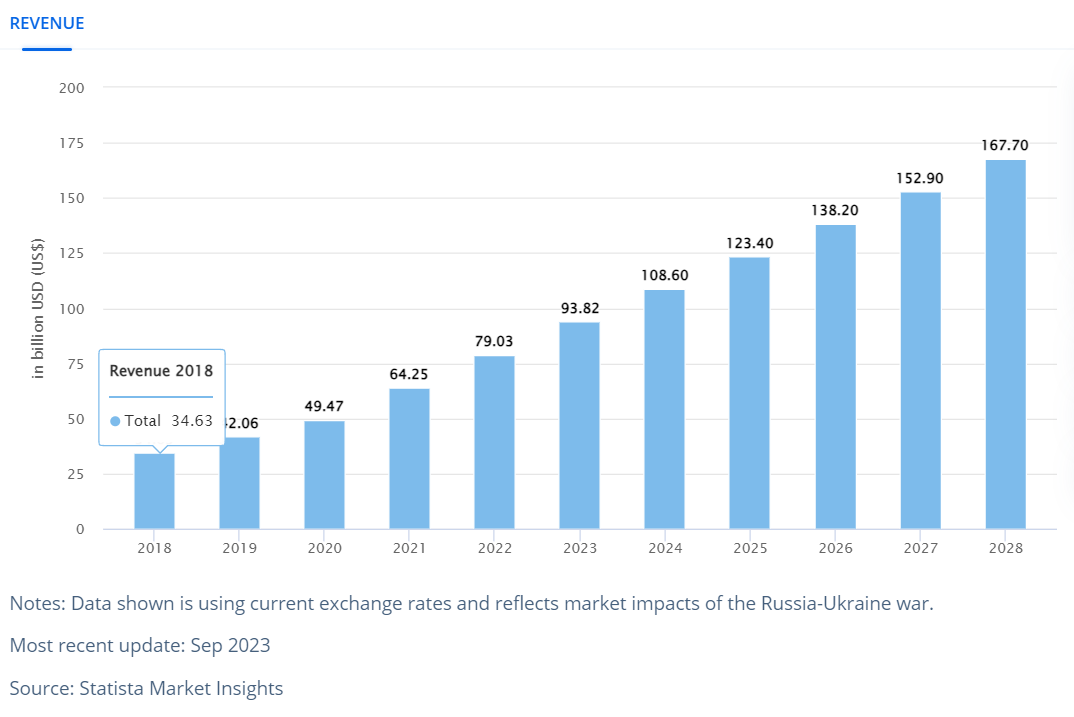
Source: Statista
Such optimistic projections are rooted in continuous innovations in wearable tech, substantial infusions of capital in healthcare IT, and universal gravitation towards personalized medical care. With the world’s health infrastructure leaning more into remote care and real-time health monitoring, the reliance on IoT is poised to intensify. In essence, we’re inching closer to a future where technology and healthcare converge, ensuring more immediate, accurate, and patient-centric interventions.
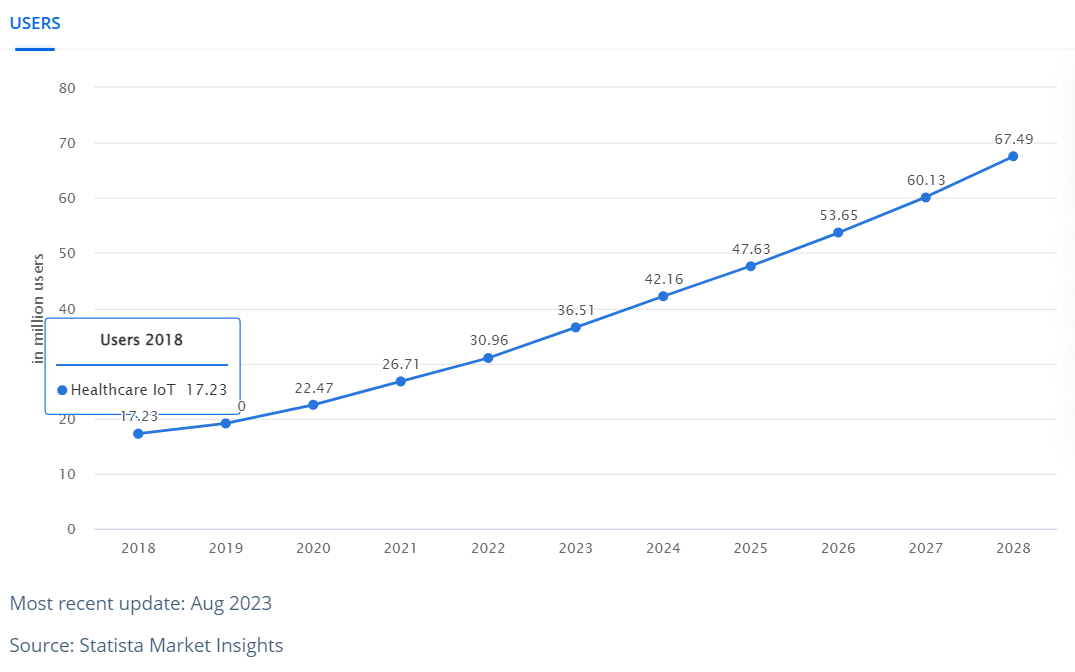
Source: Statista
Top Trends in the IoT Healthcare Market
The healthcare sector is witnessing a significant transformation with the integration of the Internet of Medical things. This technological integration is not merely an upgrade but a fundamental shift in addressing long-standing healthcare challenges. We are currently seeing a number of developments at the intersection of the Internet of Things and healthcare that deserve close attention.
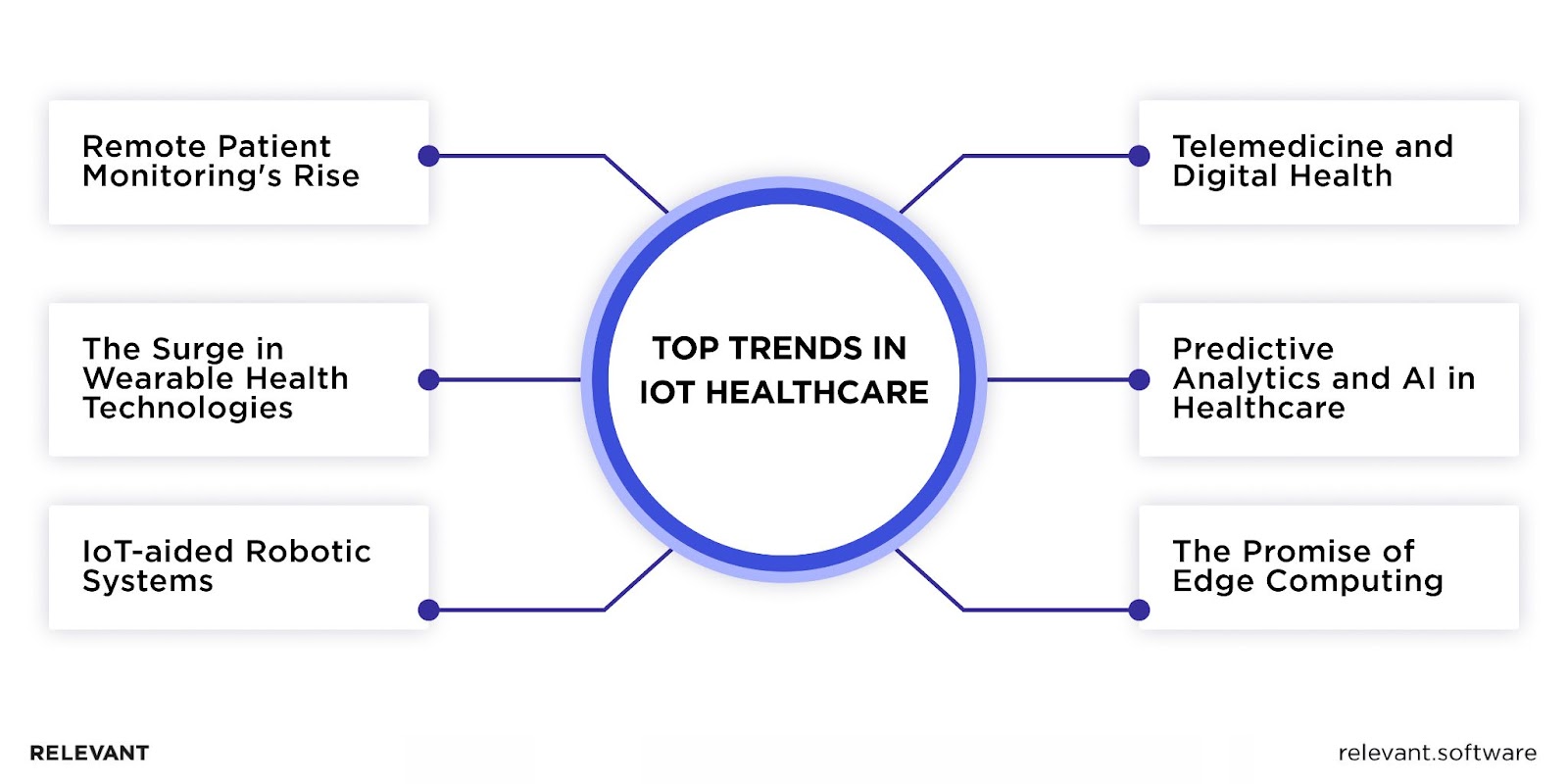
Remote Patient Monitoring’s Rise
Particularly noteworthy is the substantial increase in IoT applications within remote patient monitoring. This isn’t just a technological breakthrough but a crucial lifeline. It’s incredibly beneficial for those in remote locations or for whom regular hospital visits are challenging. IoT devices that transmit real-time health data ensure that patients get timely care and that healthcare providers can base their decisions on current information. Industry reports, including one from Frost & Sullivan, forecast that the global market for IoT-driven remote patient monitoring will reach approximately $2.13 billion by 2024.
The Surge in Wearable Health Technologies
In personal health management, wearable technologies are making waves. We’re moving from simple fitness trackers to more advanced health monitoring devices. These wearables are becoming more than just gadgets; they’re essential health tools providing real-time health data, encouraging preventive health practices, and nurturing healthier lifestyle choices. Predictions suggest that the global market for these devices, propelled by IoT technology, could reach a staggering $621 billion by 2030.
Predictive Analytics and AI in Healthcare
When IoT intersects with predictive analytics and artificial intelligence, the result is a smarter approach to healthcare. Modern IoT medical devices have evolved from passive data collectors to proactive health monitoring systems. For example, certain wearables are now capable of predicting critical health events, such as cardiac episodes, well before they occur, allowing for prompt medical intervention.
IoT-aided Robotic Systems
Integrating AI into advanced medical equipment, we’ve taken a huge leap forward with robotic surgery. These AI-driven robots make intricate surgeries more efficient and help patients recover faster. Plus, they’re not working in isolation. These robots are becoming part of a larger network, linking up with various sensors and devices in the IoT world.
Telemedicine and Digital Health
The rise of telehealth and telemedicine represents a substantial evolution in healthcare delivery. Through IoT technologies, doctors can now consult with patients who are hundreds or even thousands of miles away. Recent industry data, such as that from Arizton, indicates that by the end of 2023, the worldwide telehealth market, supercharged by IoT, might approximate a valuation of $22 billion.
The Promise of Edge Computing
By 2024, edge computing is set to redefine how we view data processing in the medical IoT framework. Unlike traditional systems that rely on distant clouds, edge computing processes data closer to its origin. The benefits are manifold: faster response times, heightened reliability, and augmented security. This is particularly transformative for remote IoT applications that demand instant data processing — think autonomous vehicles or real-time industrial processes. According to Frost & Sullivan, in 2023, edge computing generated $3.71 billion in revenue, a 172% growth compared to the previous year.
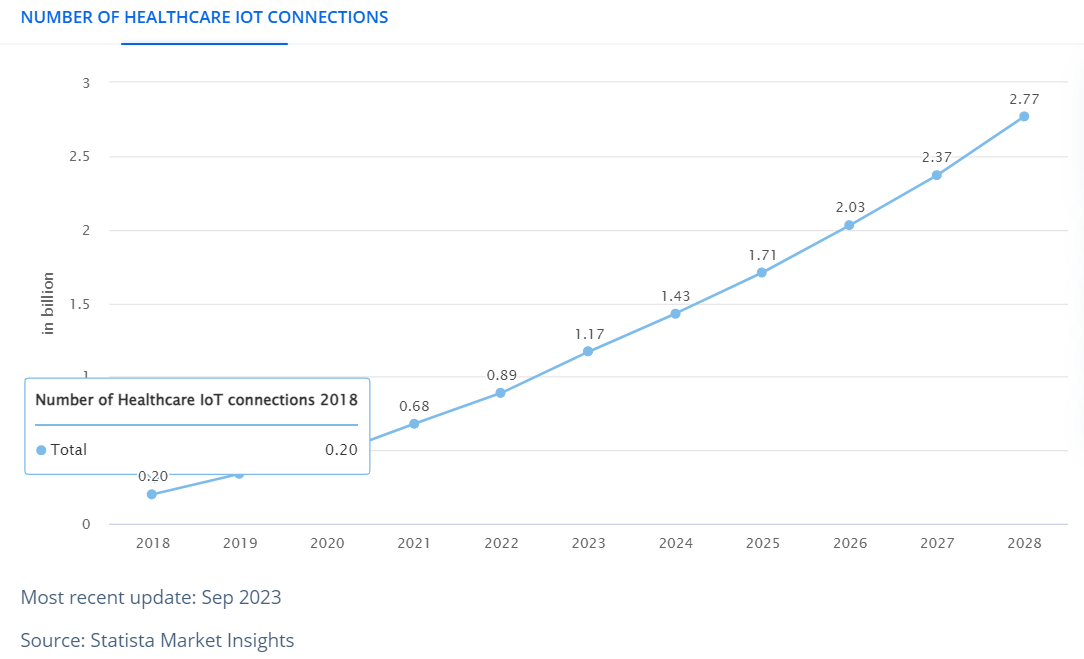
Source: Statista
Major IoT Healthcare Market Industry Players
The healthcare IoT market has created a dynamic yet moderately competitive landscape characterized by the strategic maneuvers of key industry players. Major firms actively engage in initiatives like mergers, product innovations, acquisitions, and collaborations, all geared toward solidifying their standing in the market. Notable companies leading these efforts include Abbott Laboratories, Boston Scientific, Medtronic, Koninklijke Philips NV, Honeywell Life Care Solutions, and Biotronik.
March 2023 witnessed Fujitsu stepping into the spotlight by unveiling a groundbreaking cloud-based platform. The platform aims to revolutionize the way health-related data is collected and used and will lead the digital transformation in the healthcare industry. Its standout feature is the ability to seamlessly convert medical data from electronic medical records into the next-gen standard framework HL7 FHIR, ensuring both secure data aggregation and compliance.
In a similar stride, 2023 also marked a significant milestone for Microsoft with the launch of the innovative Dragon Ambient eXperience (DAX) Express. This application is a game-changer in clinical documentation, harmoniously integrating automated workflows. What sets DAX Express apart is its unique blend of conversational and environmental AI, augmented by the advanced reasoning and natural language processing prowess of OpenAI’s GPT-4. This integration not only simplifies but revolutionizes the documentation process in clinical settings.
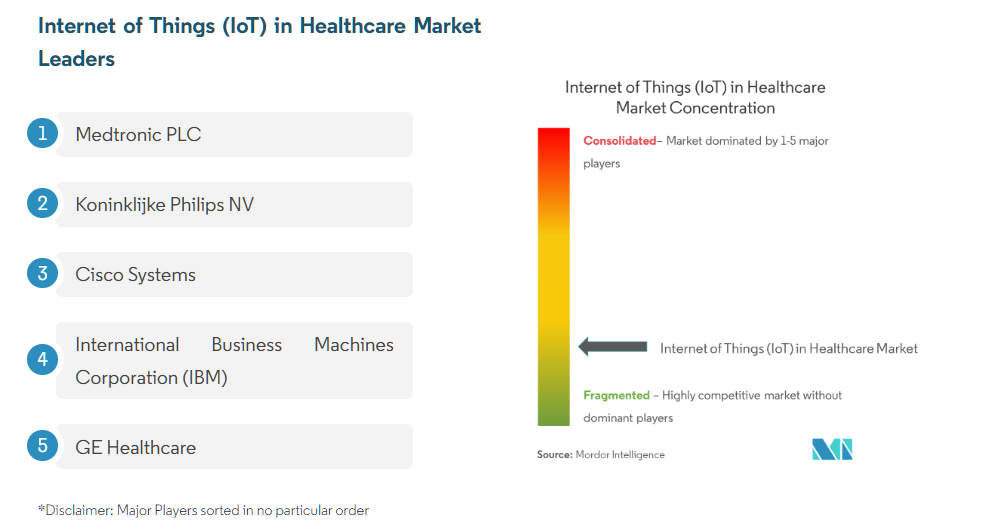
Source: Mordor Intelligence
Barriers to Entry IoT in the Healthcare Industry
The growth and innovation of the IoT in the healthcare industry often hit a roadblock in the form of outdated infrastructure. As the digital age propels us forward with smart gadgets and interconnected wonders, our legacy systems grapple, often unsuccessfully, with the demands of contemporary IoT tech.
These dated frameworks range from old-school hardware, unfit for the nuances of modern IoT, to archaic network setups that lag inefficient data relay and processing. Beyond mere performance issues, these aging systems become hotspots for security vulnerabilities, making them easy targets for cyber-attacks.
The consequences are twofold. On the one hand, businesses and urban spaces dependent on these old systems face obstacles in fully embracing the IoT revolution. On the other, the financial and logistical weight of overhauling these systems becomes a hefty burden, particularly for smaller entities or those in financially constrained regions.
This widening rift between cutting-edge IoT advancements and the decaying infrastructure paints a clear picture: a pressing need for proactive investment, expert IoT software development, and strategy for upgrading old systems, prepping them for the digital marvels of the future. Hence, you’ll need a trustworthy partner and supporter in your corner.
The Value of Partnering with Relevant
Partnering with a trusted IoT development company like Relevant means diving into a pool of practical, dynamic expertise. We’re not just another team; we’re building custom IoT solutions that have actively transformed our clients’ operations.
- IoT in healthcare is ever-changing, and we’re attuned to its pulse. Expect more than standard service with us; we’re your advisors in a landscape where the latest healthcare technology trends and advancements matter. We keep you ahead, ensuring your project doesn’t just meet but exceeds contemporary standards.
- Challenges in the healthcare IoT security market are no joke. We take it seriously, fortifying your IoT solutions against threats. With us, your data is protected, and user confidence is a given.
- Your journey doesn’t end with the launch. The use of IoT in the healthcare industry demands continual monitoring, and we’re here for it, tackling challenges and keeping your system at peak performance.
In essence, choosing Relevant is about forging a partnership that goes beyond mere transactions. It’s about embracing innovation, security, and a relationship that’s set to last and evolve with your success.
Our core services:
Do you want a price estimate for your project?
Do you know that we helped 200+ companies build web/mobile apps and scale dev teams?
Let's talk about your engineering needs.
Write to us











